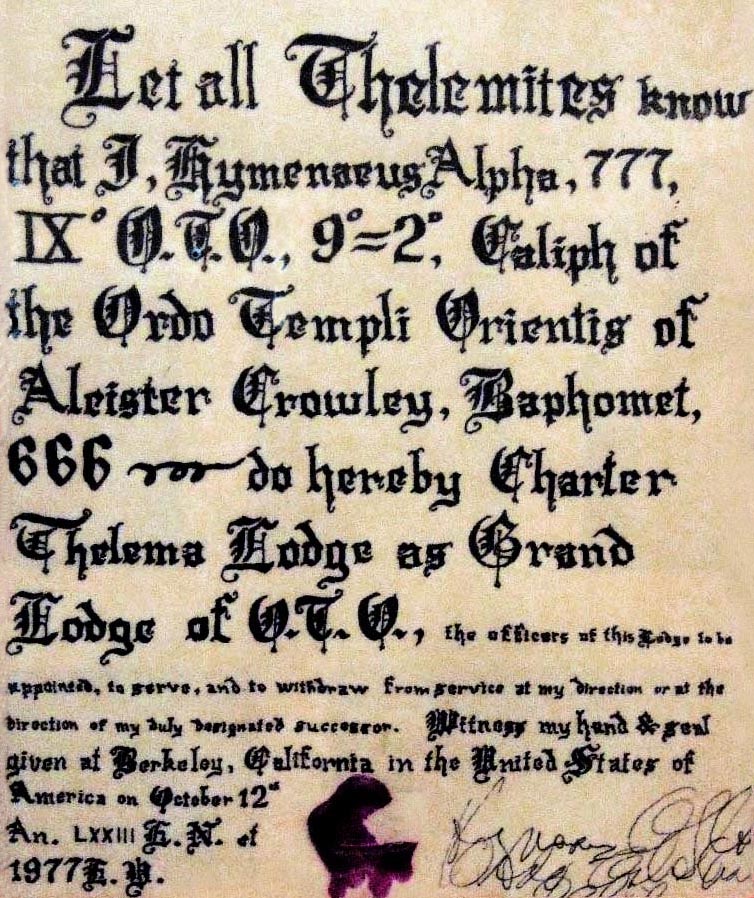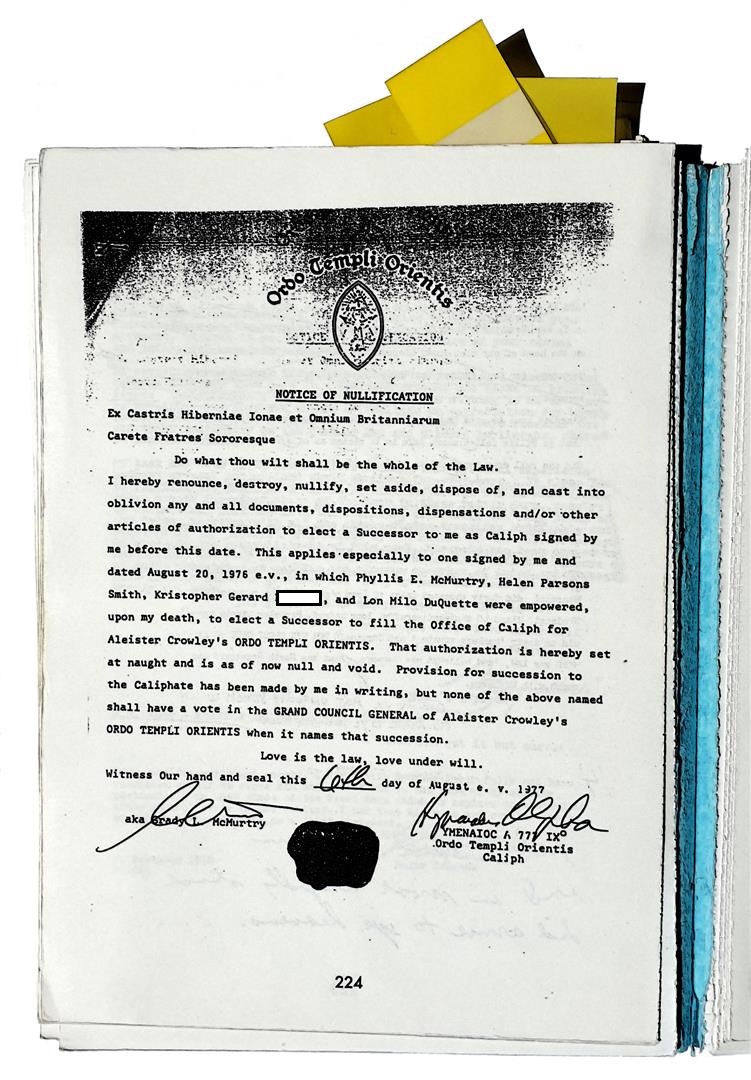The Ordo Templi Orientis Phenomenon
The 'Caliphate'

Founding charter of the 'Caliphate',
or more precisely, of the contemporary American O.T.O.
The Ordo Templi Orientis Phenomenon
|
|---|
|
The sacral legitimacy of esoteric organisations rarely derives from institutional continuity; more commonly, it is the result of symbolic construction. The so-called 'Caliphate' O.T.O., revived by Grady McMurtry in the late 1970s, exemplifies this dynamic. In such cases, authority is not transmitted via regulated succession but rather produced through narrative reinterpretation, performative acts, legal formalisation, and internal consensus.
This constructivist character became particularly evident in 1977, when a newly reconstituted American branch of the O.T.O., styling itself the 'Caliphate', proclaimed its global jurisdiction. At its centre stood Grady Louis McMurtry (1918–1985), who issued a formal declaration asserting the group's authority. The document read: “Let all Thelemites know that I, Hymenaeus Alpha, 777 IX° O.T.O., 9°=2□, Caliph of the Ordo Templi Orientis of Aleister Crowley, Baphomet, 666, do hereby Charter Thelema Lodge as Grand Lodge of O.T.O.” The 'Caliphate' presents itself as a new religious movement garbed in the trappings of tradition. Its mechanisms of governance combine modern legal-rational forms — bylaws, elections, intellectual property claims — with archaic elements such as mystical charisma, esoteric symbology, and the strategic use of secret or canonised documents. In this sense, it constitutes a paradigmatic instance of institutional mythopoesis: elements of Aleister Crowley’s symbolic authority are selectively appropriated, transformed, or recontextualised to legitimise new administrative structures. Its history is a Song of the Whitewash. The background of the emergence of this new American O.T.O. lies in the History of the Solar Lodge of the O.T.O.. Solar Lodge and the 'Caliphate': Documents from the Early Struggles. William Breeze, McMurtry’s successor, subsequently buried the original construct — ‘Caliphate’ — deep within the organisation’s bylaws, where, tucked away in Section 3.10 (“Removal of Acting O.H.O. or Caliph”), he implicitly concedes that the ‘Caliphate’ is, after all, merely a constructed designation. |
|

|
|
The so-called 'Caliphate' O.T.O. rests not on unbroken succession but on a reconstituted narrative of continuity. The authority of McMurtry, and by extension Breeze, depends not on the preservation of ritual and constitutional transmission, but on an adaptive, post facto rationalization of legitimacy through legal incorporation, selective myth-making, and symbolic association with Crowley.
As for the copyrights to Aleister Crowley’s works: since no inheritance had occurred, they had to be acquired. They were available at a modest cost from the British Crown. Voilà. A selection of critical materials illuminating the symbolic, legal, and organisational dynamics within the post-McMurtry 'Caliphate' O.T.O.: – A foundational debate concerning the so-called instrument of succession: this page provides introductory context, a full transcript of the discussion, and an MP3 audio recording of the original conversation. – David Scriven’s officially sanctioned and now “revised” History of the O.T.O., which has come to mirror independent archival findings more closely over time. – An ex-IX° member’s recollections of internal dynamics, disciplinary mechanisms, and cultural atmosphere. See also the full Collection of Re-Collections for comparative testimony — such as the tale of Grady Louis McMurtry, who is said to have relieved himself on a baby while in a state of heroic intoxication. 
[AI-generated image] – Regional case studies: "Ljuben je zakon" or "ljubav pod voljom"? examines the O.T.O.’s presence in post-Yugoslav territories. The Canadian context is discussed in "Moosebump", exploring the 'Caliphate's' northern expansion. – A legal rupture within the order: James T. Graeb, IX° and co-founder of the 'Caliphate', initiated a lawsuit in 2001 against Breeze, Heidrick, and Jungkurth, among others. The case was dismissed in April 2002. – An anonymous 2021 exposé, "Burning Down The House", explores intersections between the 'Caliphate' O.T.O., the Argenteum Astrum, James Wasserman, and contemporary right-wing political currents. – A personal reflection by David King on his brother, Patrick King, self-declared XI° of the 'Caliphate', accompanied by photographic material. – Cartographic and symbolic mappings of the early decades of the order’s reconstitution are explored in "Maps and Magick: Mapping the 'Caliphate' 1977–1994". – A wide-ranging collection of facsimiles, documents, letters, and photographs is available here: Pictures + Documents. – A report on ritual and doctrinal rupture: “The Gnostic Catholic Church Boast”, which outlines how William Breeze forfeited apostolic succession.   
– Oscar R. Schlag, a self-styled "last grey eminence," occupies a liminal position in the esoteric networks surrounding the postwar O.T.O. milieu. His connections span from Jane Wolfe and Marcelo Ramos Motta to Choronzon Club circles, Karl Germer, and H.J. Metzger. – Regional variants and contested lineages: a report on One O.T.O. in Brazil offers insight into the complex reception of Thelemic structures in South America. – Euclydes Lacerda de Almeida reflects on the enigmatic legacy of Marcelo Ramos Motta, a central but polarising figure in the transmission of Thelema in Brazil. – Marcelo A.C. Santos provides a critical reconstruction in "A Verdadeira História do 'Califado' no Brasil", tracing the emergence and fractures of Thelemic authority in the Brazilian context. – Michael Staley offers an interpretive essay on ""The Babalon Working", exploring Jack Parsons’ ritual experiment and its occult legacy. This is complemented by an appreciation of Marjorie Cameron, whose artistic and visionary contributions continue to resonate in post-Parsons esotericism. – Nikolas and Zeena Schreck’s "Demons of the Flesh" presents a broader reflection on sex magick, dualism, and the interface of esoteric praxis and cultural critique. 
[From: 'Materialien Zum O.T.O.']
Consecration In Transit. How, why, and where was the 'Caliphate' Ecclesia Gnostica Catholica constructed — not inherited? In the backseat of a car, as William Heidrick described it: a pragmatic act performed en route to a notary. Not a rite of transmission, but a bureaucratic sleight of hand — sacral authority improvised to meet tax–exempt requirements. Grady McMurtry, facing collapse and solitude, later confessed to having activated the ‘Caliphate’ in “an afternoon of despair,” armed only with Crowley’s ambiguous paperwork. The article traces the key mechanisms by which legal recognition was secured — not through apostolic lineage, but via incorporation documents and strategic improvisation. A textbook case of how modern esotericism manufactures legitimacy through administrative ritual and retrospective meaning. 
[AI–generated image] A triadic e-mail exchange between William Heidrick, Grand Treasurer General of the 'Caliphate' O.T.O., Tyagi Nagasiva (also known as Fr. Nigris), and Peter-R. Koenig explores a range of doctrinal, administrative, and symbolic disputes within the organisation. The full correspondence includes discussions of:
This exchange (dated August 19 – September 17, 1996) is particularly significant in that it features William Heidrick, who is often regarded as the third-ranking figure in the 'Caliphate' hierarchy, after William Breeze (Hymenaeus Beta) and David Scriven (Frater Sabazius X°). Informally, Heidrick has sometimes been described as the 'Caliphate’s de facto spin doctor' — known for reframing facts in ways that favour Grady McMurtry, Breeze, and the official organisational narrative. The correspondence articulates a deep-seated tension between mythic continuity and critical historiography; between esoteric authority grounded in lived initiation and the imperatives of documentary transparency; and between sacralized secrecy and the modern demand for institutional accountability — all of which unfold within the contested symbolic economy of the postmodern era.
— Nagasiva: I'm unsure of the significance of the question but would like to hear a response. — Heidrick: I say it, therefore it is so. 
[AI–generated image] An extensive e-mail correspondence between Peter-R. Koenig and David Scriven, Grand Master X° of the North American 'Caliphate', addresses both historical and theoretical questions surrounding the legitimacy and development of the order. Scriven appears as the priestly steward, guarding a fragile orthodoxy assembled from ritual fragments and legal scaffolding. Koenig takes on the rôle of the heretical questioner, pressing for historical coherence and transparency. The full correspondence is divided into five parts: Topics addressed in the exchange include:
Notable figures such as Phyllis Seckler, Helen Parsons Smith, and Andrea Bacuzzi appear throughout the correspondence — though mostly as peripheral participants, not as bearers of institutional authority. Whether women could or should have had a say in succession or governance is never mentioned — presumably because no one thought to ask. This correspondence, spanning from September 1 to November 29, 1996, was initiated in response to Scriven’s publication of an official historical account of the founding of the 'Caliphate'. This narrative diverged significantly from Koenig’s earlier reconstruction, the pointedly titled "Song of the Whitewash". Beneath the surface, the exchange reflects a deeper anxiety over the fragility of institutional memory and the difficulty of maintaining esoteric continuity within a modern bureaucratic structure. Phrases like “I don’t have access,” “that document is lost,” “I’ll try to obtain it” recur throughout the dialogue. Scriven’s admission that key documents are held by different individuals — “Heidrick has that,” “Iannotti controls the archive,” “Lon recalls...” — suggests a fragmented and possibly irretrievable evidentiary core. William Heidrick’s public stance regarding the publication of this correspondence is encapsulated in the following statement: "In particular, I will not read or discuss material stolen by Koenig in the case of letters of the US Xth degree, made public in violation of copyright." The 'Caliphate' is neither the sole legitimate heir nor an outright usurper, but rather an institutional bricolage — assembled from fragments of charisma, paperwork, and symbolic capital. It exemplifies a paradigm not uncommon in the invention of magical and religious orders. Its myth doesn’t need wheels — only repetition. Stories aren’t lines; they’re loops. Gaps in the Script of Esotericism: Hypocrisy and Hypercrisis. Religious affiliation has influenced academic research throughout history, with numerous scholars shaping their work to align with or legitimize their personal beliefs. Examples include Carl Schmitt ("Political Theology", 1922), who linked sovereignty to theological concepts; Immanuel Velikovsky ("Worlds in Collision", 1950), who sought to reconcile biblical events with scientific theories; and Georges Lemaître (1927), whose "Big Bang Theory" was sometimes framed in relation to Christian creation narratives. In esoteric studies, researchers are often either sympathizers or critics of the movement they study, leading to biases in both directions. A common methodological issue is the selective omission of inconvenient facts, allowing scholars to construct a favorable narrative by curating sources. Academics who are also members of the O.T.O. have a clear incentive to present the organization in a positive light. Such scholars often adopt an academic stance that frames the O.T.O. as a "Western mystery tradition" or "spiritual system" rather than an obscure occult order. Scientific neutrality in such contexts is frequently an illusion, as authors tend to downplay or reinterpret critical aspects when writing about their own religious affiliations. Controversial topics such as ritual sexual practices, authoritarian structures, or Crowley’s problematic history — including racism, drug addiction, and allegations of abuse — are often ignored or dismissed as "misunderstandings". The ultimate goal is to integrate the O.T.O. into the academic study of religion, lending it credibility and mainstream legitimacy, making these scholars function more as an "academic PR division" than as neutral investigators. In the realm of academia, scholars, preoccupied with their interpretations of archived knowledge, form insular communities. Occultists disguise themselves as scholars, and vice versa. Laypersons, adept at employing langue de bois rhetoric, gravitate towards their preferred online platforms. A culture of self–affirmation prevails, accompanied by a chorus of indignant condemnation directed at others. Articles by Jerry Cornelius:
|


|
|
|
|
|
|